Aboriginal and Torres Islander History: Cultural Heritage and Discrimination
VerifiedAdded on 2023/06/08
|5
|1476
|137
AI Summary
This essay discusses the social and political history of aboriginal and Torres Strait islanders and their differential cultural and beliefs that discriminated them from the rest of the Australians. It also discusses the factors that force these people to suffer from common diseases racial trauma and a few short strategies to involve them into the mainstream Australian society.
Contribute Materials
Your contribution can guide someone’s learning journey. Share your
documents today.
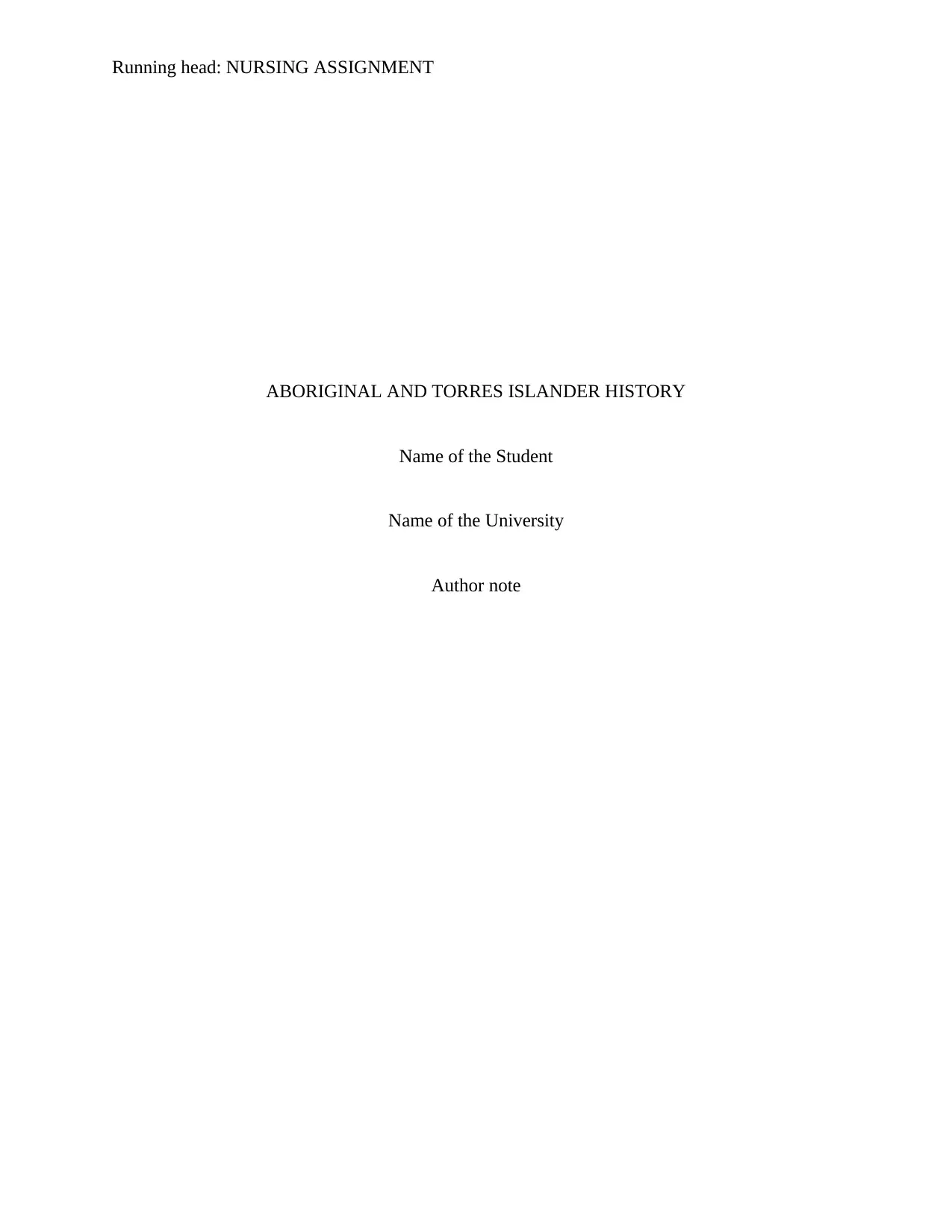
Running head: NURSING ASSIGNMENT
ABORIGINAL AND TORRES ISLANDER HISTORY
Name of the Student
Name of the University
Author note
ABORIGINAL AND TORRES ISLANDER HISTORY
Name of the Student
Name of the University
Author note
Secure Best Marks with AI Grader
Need help grading? Try our AI Grader for instant feedback on your assignments.
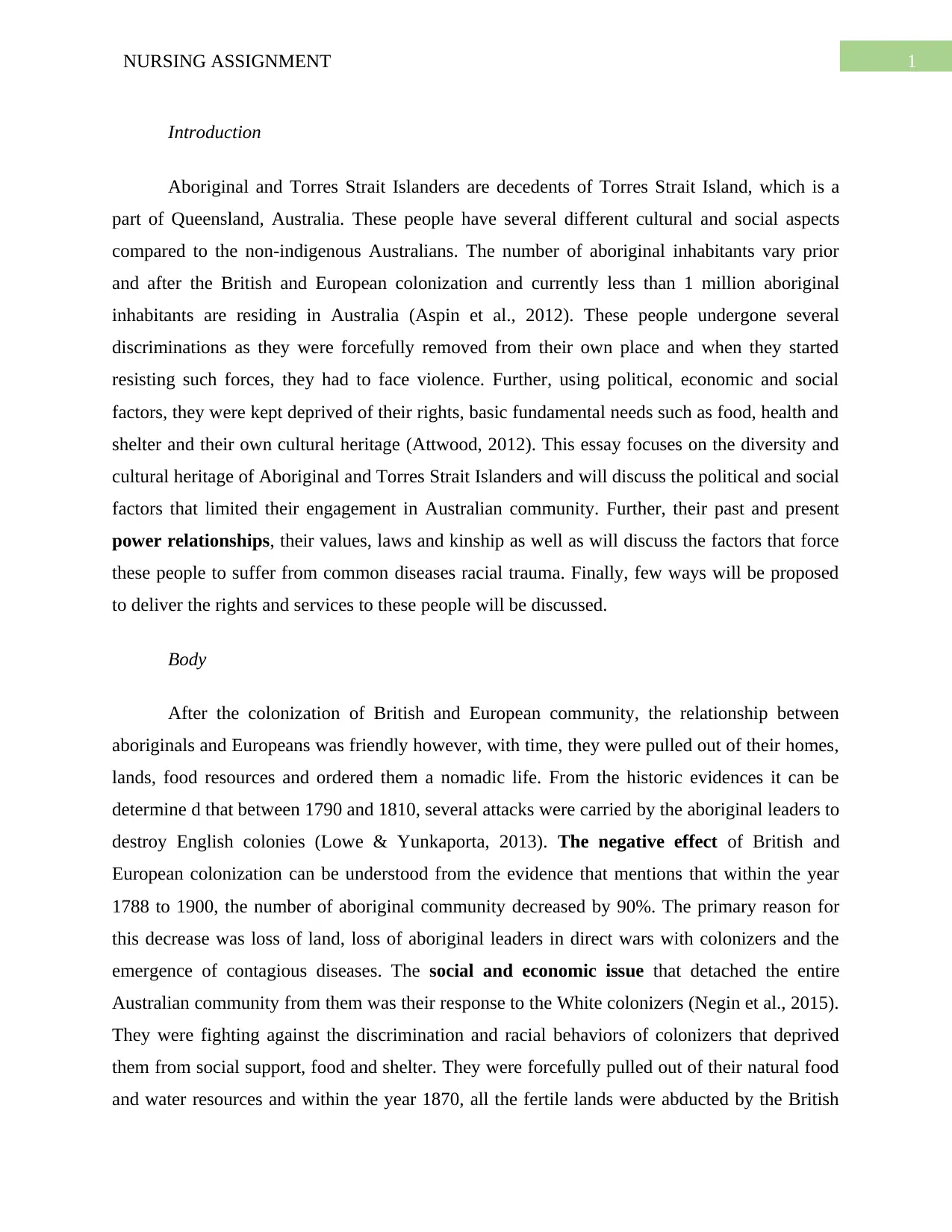
1NURSING ASSIGNMENT
Introduction
Aboriginal and Torres Strait Islanders are decedents of Torres Strait Island, which is a
part of Queensland, Australia. These people have several different cultural and social aspects
compared to the non-indigenous Australians. The number of aboriginal inhabitants vary prior
and after the British and European colonization and currently less than 1 million aboriginal
inhabitants are residing in Australia (Aspin et al., 2012). These people undergone several
discriminations as they were forcefully removed from their own place and when they started
resisting such forces, they had to face violence. Further, using political, economic and social
factors, they were kept deprived of their rights, basic fundamental needs such as food, health and
shelter and their own cultural heritage (Attwood, 2012). This essay focuses on the diversity and
cultural heritage of Aboriginal and Torres Strait Islanders and will discuss the political and social
factors that limited their engagement in Australian community. Further, their past and present
power relationships, their values, laws and kinship as well as will discuss the factors that force
these people to suffer from common diseases racial trauma. Finally, few ways will be proposed
to deliver the rights and services to these people will be discussed.
Body
After the colonization of British and European community, the relationship between
aboriginals and Europeans was friendly however, with time, they were pulled out of their homes,
lands, food resources and ordered them a nomadic life. From the historic evidences it can be
determine d that between 1790 and 1810, several attacks were carried by the aboriginal leaders to
destroy English colonies (Lowe & Yunkaporta, 2013). The negative effect of British and
European colonization can be understood from the evidence that mentions that within the year
1788 to 1900, the number of aboriginal community decreased by 90%. The primary reason for
this decrease was loss of land, loss of aboriginal leaders in direct wars with colonizers and the
emergence of contagious diseases. The social and economic issue that detached the entire
Australian community from them was their response to the White colonizers (Negin et al., 2015).
They were fighting against the discrimination and racial behaviors of colonizers that deprived
them from social support, food and shelter. They were forcefully pulled out of their natural food
and water resources and within the year 1870, all the fertile lands were abducted by the British
Introduction
Aboriginal and Torres Strait Islanders are decedents of Torres Strait Island, which is a
part of Queensland, Australia. These people have several different cultural and social aspects
compared to the non-indigenous Australians. The number of aboriginal inhabitants vary prior
and after the British and European colonization and currently less than 1 million aboriginal
inhabitants are residing in Australia (Aspin et al., 2012). These people undergone several
discriminations as they were forcefully removed from their own place and when they started
resisting such forces, they had to face violence. Further, using political, economic and social
factors, they were kept deprived of their rights, basic fundamental needs such as food, health and
shelter and their own cultural heritage (Attwood, 2012). This essay focuses on the diversity and
cultural heritage of Aboriginal and Torres Strait Islanders and will discuss the political and social
factors that limited their engagement in Australian community. Further, their past and present
power relationships, their values, laws and kinship as well as will discuss the factors that force
these people to suffer from common diseases racial trauma. Finally, few ways will be proposed
to deliver the rights and services to these people will be discussed.
Body
After the colonization of British and European community, the relationship between
aboriginals and Europeans was friendly however, with time, they were pulled out of their homes,
lands, food resources and ordered them a nomadic life. From the historic evidences it can be
determine d that between 1790 and 1810, several attacks were carried by the aboriginal leaders to
destroy English colonies (Lowe & Yunkaporta, 2013). The negative effect of British and
European colonization can be understood from the evidence that mentions that within the year
1788 to 1900, the number of aboriginal community decreased by 90%. The primary reason for
this decrease was loss of land, loss of aboriginal leaders in direct wars with colonizers and the
emergence of contagious diseases. The social and economic issue that detached the entire
Australian community from them was their response to the White colonizers (Negin et al., 2015).
They were fighting against the discrimination and racial behaviors of colonizers that deprived
them from social support, food and shelter. They were forcefully pulled out of their natural food
and water resources and within the year 1870, all the fertile lands were abducted by the British
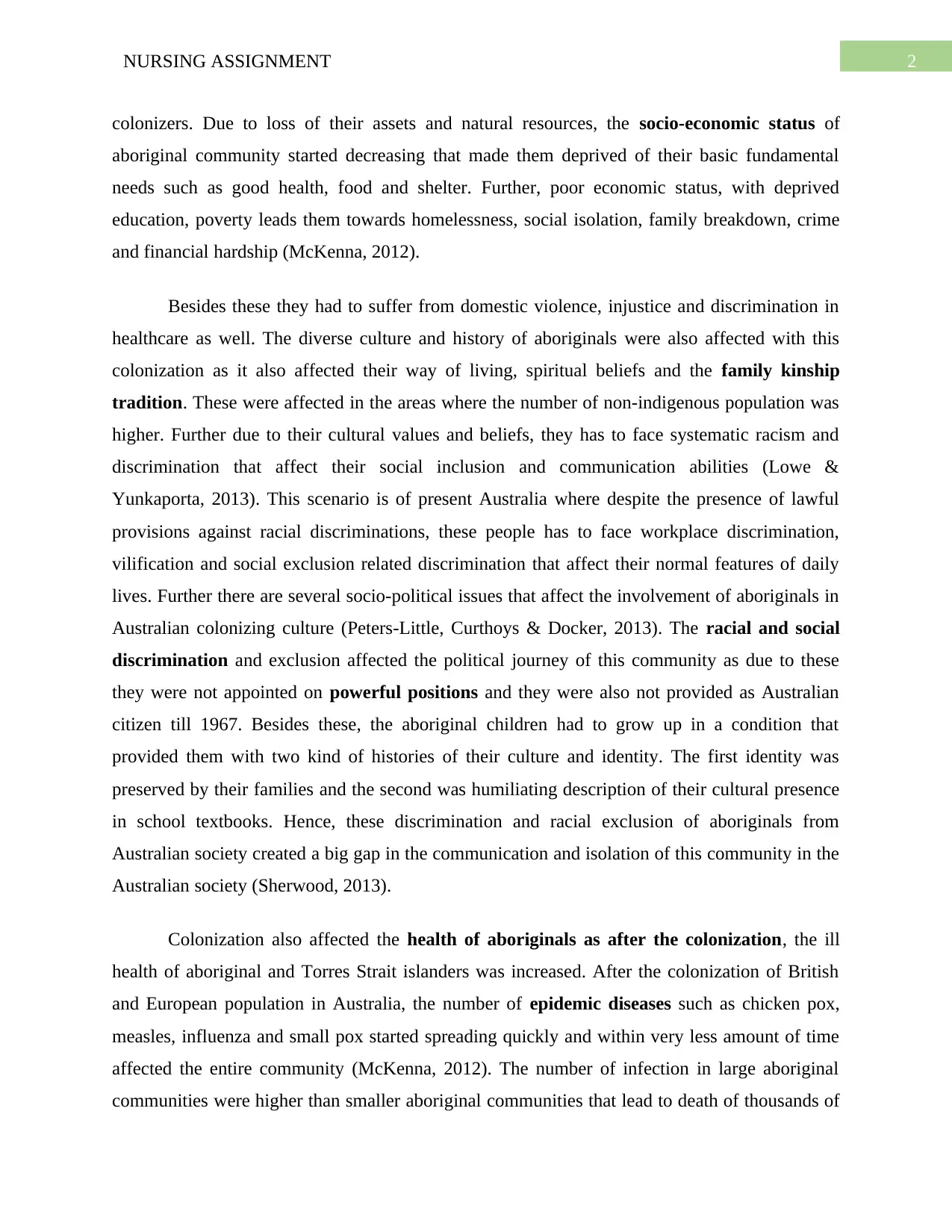
2NURSING ASSIGNMENT
colonizers. Due to loss of their assets and natural resources, the socio-economic status of
aboriginal community started decreasing that made them deprived of their basic fundamental
needs such as good health, food and shelter. Further, poor economic status, with deprived
education, poverty leads them towards homelessness, social isolation, family breakdown, crime
and financial hardship (McKenna, 2012).
Besides these they had to suffer from domestic violence, injustice and discrimination in
healthcare as well. The diverse culture and history of aboriginals were also affected with this
colonization as it also affected their way of living, spiritual beliefs and the family kinship
tradition. These were affected in the areas where the number of non-indigenous population was
higher. Further due to their cultural values and beliefs, they has to face systematic racism and
discrimination that affect their social inclusion and communication abilities (Lowe &
Yunkaporta, 2013). This scenario is of present Australia where despite the presence of lawful
provisions against racial discriminations, these people has to face workplace discrimination,
vilification and social exclusion related discrimination that affect their normal features of daily
lives. Further there are several socio-political issues that affect the involvement of aboriginals in
Australian colonizing culture (Peters-Little, Curthoys & Docker, 2013). The racial and social
discrimination and exclusion affected the political journey of this community as due to these
they were not appointed on powerful positions and they were also not provided as Australian
citizen till 1967. Besides these, the aboriginal children had to grow up in a condition that
provided them with two kind of histories of their culture and identity. The first identity was
preserved by their families and the second was humiliating description of their cultural presence
in school textbooks. Hence, these discrimination and racial exclusion of aboriginals from
Australian society created a big gap in the communication and isolation of this community in the
Australian society (Sherwood, 2013).
Colonization also affected the health of aboriginals as after the colonization, the ill
health of aboriginal and Torres Strait islanders was increased. After the colonization of British
and European population in Australia, the number of epidemic diseases such as chicken pox,
measles, influenza and small pox started spreading quickly and within very less amount of time
affected the entire community (McKenna, 2012). The number of infection in large aboriginal
communities were higher than smaller aboriginal communities that lead to death of thousands of
colonizers. Due to loss of their assets and natural resources, the socio-economic status of
aboriginal community started decreasing that made them deprived of their basic fundamental
needs such as good health, food and shelter. Further, poor economic status, with deprived
education, poverty leads them towards homelessness, social isolation, family breakdown, crime
and financial hardship (McKenna, 2012).
Besides these they had to suffer from domestic violence, injustice and discrimination in
healthcare as well. The diverse culture and history of aboriginals were also affected with this
colonization as it also affected their way of living, spiritual beliefs and the family kinship
tradition. These were affected in the areas where the number of non-indigenous population was
higher. Further due to their cultural values and beliefs, they has to face systematic racism and
discrimination that affect their social inclusion and communication abilities (Lowe &
Yunkaporta, 2013). This scenario is of present Australia where despite the presence of lawful
provisions against racial discriminations, these people has to face workplace discrimination,
vilification and social exclusion related discrimination that affect their normal features of daily
lives. Further there are several socio-political issues that affect the involvement of aboriginals in
Australian colonizing culture (Peters-Little, Curthoys & Docker, 2013). The racial and social
discrimination and exclusion affected the political journey of this community as due to these
they were not appointed on powerful positions and they were also not provided as Australian
citizen till 1967. Besides these, the aboriginal children had to grow up in a condition that
provided them with two kind of histories of their culture and identity. The first identity was
preserved by their families and the second was humiliating description of their cultural presence
in school textbooks. Hence, these discrimination and racial exclusion of aboriginals from
Australian society created a big gap in the communication and isolation of this community in the
Australian society (Sherwood, 2013).
Colonization also affected the health of aboriginals as after the colonization, the ill
health of aboriginal and Torres Strait islanders was increased. After the colonization of British
and European population in Australia, the number of epidemic diseases such as chicken pox,
measles, influenza and small pox started spreading quickly and within very less amount of time
affected the entire community (McKenna, 2012). The number of infection in large aboriginal
communities were higher than smaller aboriginal communities that lead to death of thousands of
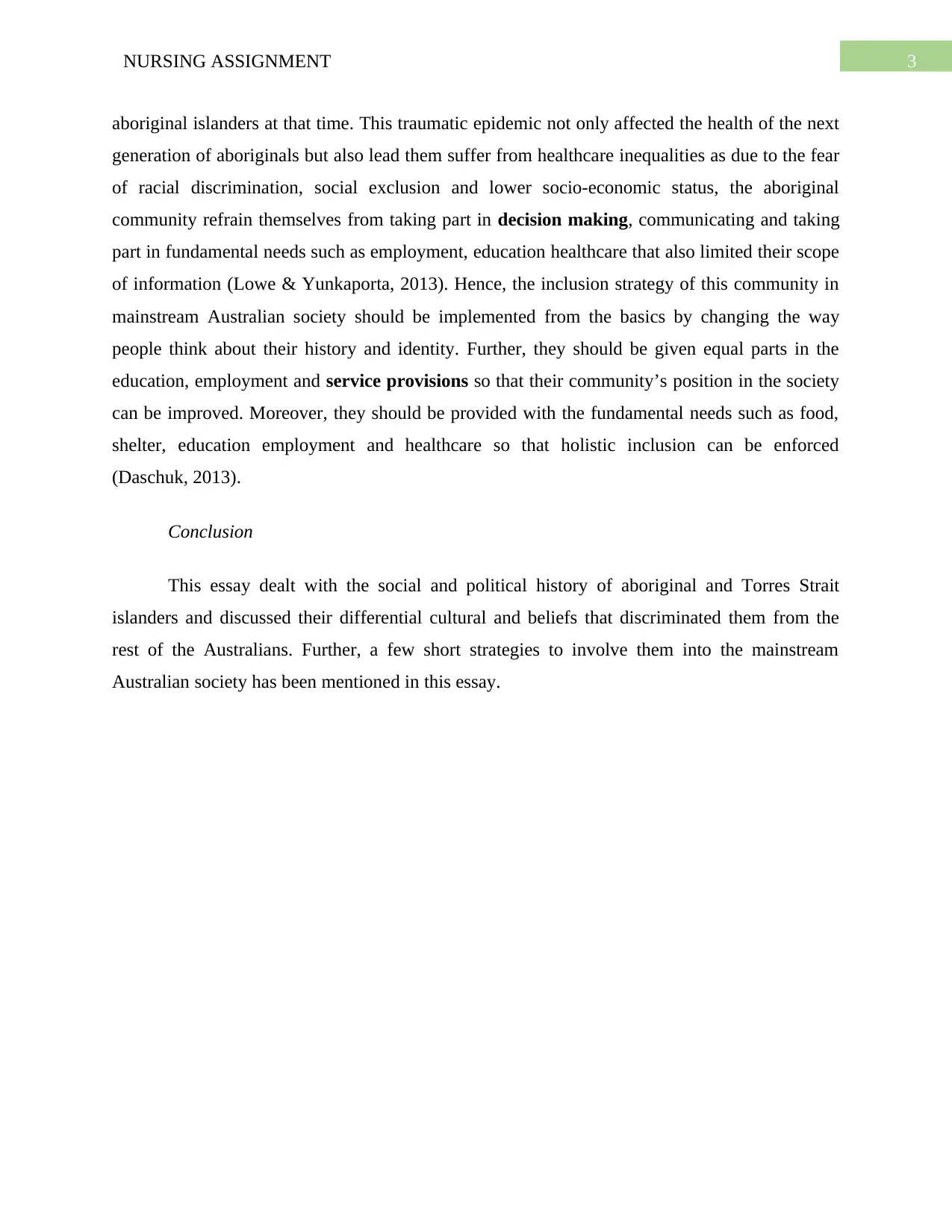
3NURSING ASSIGNMENT
aboriginal islanders at that time. This traumatic epidemic not only affected the health of the next
generation of aboriginals but also lead them suffer from healthcare inequalities as due to the fear
of racial discrimination, social exclusion and lower socio-economic status, the aboriginal
community refrain themselves from taking part in decision making, communicating and taking
part in fundamental needs such as employment, education healthcare that also limited their scope
of information (Lowe & Yunkaporta, 2013). Hence, the inclusion strategy of this community in
mainstream Australian society should be implemented from the basics by changing the way
people think about their history and identity. Further, they should be given equal parts in the
education, employment and service provisions so that their community’s position in the society
can be improved. Moreover, they should be provided with the fundamental needs such as food,
shelter, education employment and healthcare so that holistic inclusion can be enforced
(Daschuk, 2013).
Conclusion
This essay dealt with the social and political history of aboriginal and Torres Strait
islanders and discussed their differential cultural and beliefs that discriminated them from the
rest of the Australians. Further, a few short strategies to involve them into the mainstream
Australian society has been mentioned in this essay.
aboriginal islanders at that time. This traumatic epidemic not only affected the health of the next
generation of aboriginals but also lead them suffer from healthcare inequalities as due to the fear
of racial discrimination, social exclusion and lower socio-economic status, the aboriginal
community refrain themselves from taking part in decision making, communicating and taking
part in fundamental needs such as employment, education healthcare that also limited their scope
of information (Lowe & Yunkaporta, 2013). Hence, the inclusion strategy of this community in
mainstream Australian society should be implemented from the basics by changing the way
people think about their history and identity. Further, they should be given equal parts in the
education, employment and service provisions so that their community’s position in the society
can be improved. Moreover, they should be provided with the fundamental needs such as food,
shelter, education employment and healthcare so that holistic inclusion can be enforced
(Daschuk, 2013).
Conclusion
This essay dealt with the social and political history of aboriginal and Torres Strait
islanders and discussed their differential cultural and beliefs that discriminated them from the
rest of the Australians. Further, a few short strategies to involve them into the mainstream
Australian society has been mentioned in this essay.
Secure Best Marks with AI Grader
Need help grading? Try our AI Grader for instant feedback on your assignments.
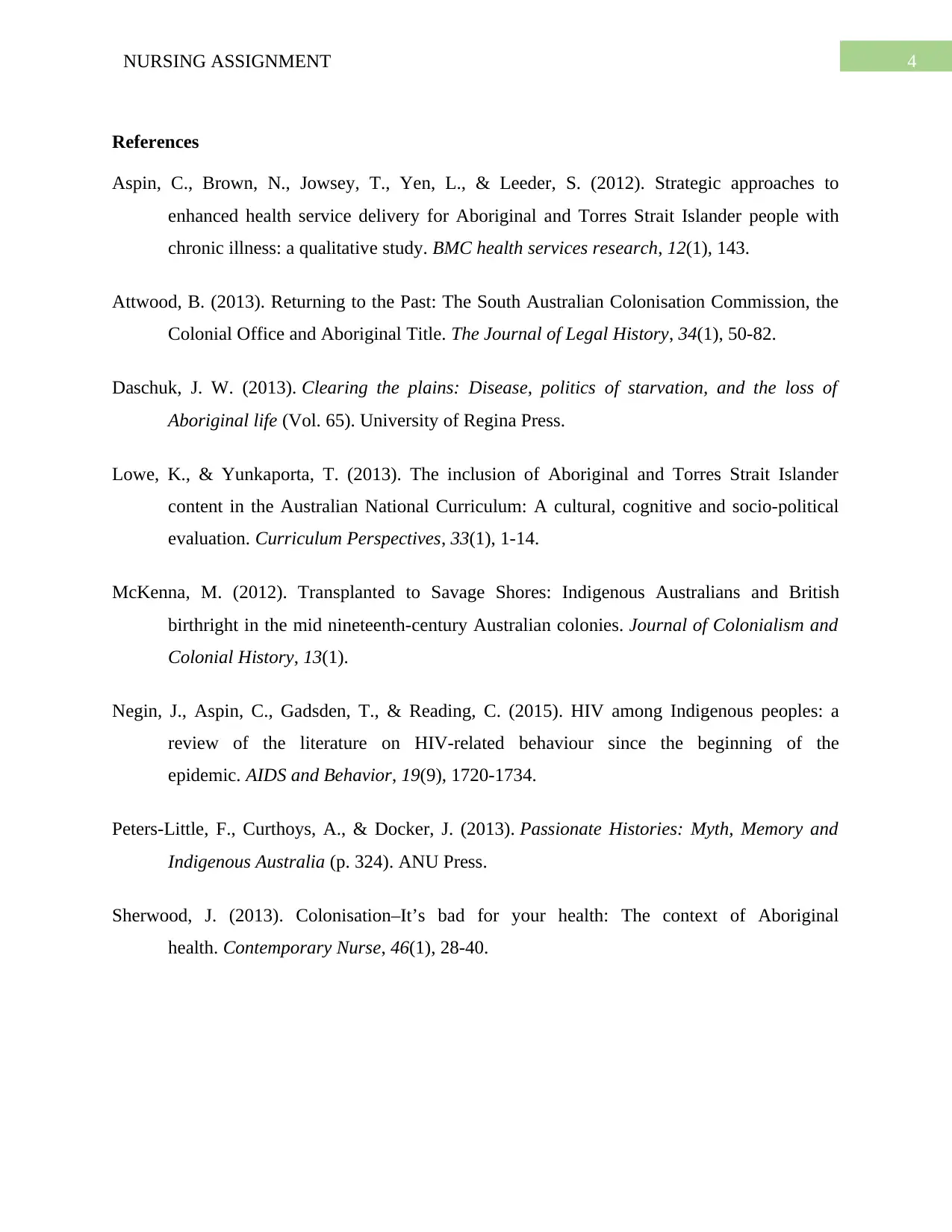
4NURSING ASSIGNMENT
References
Aspin, C., Brown, N., Jowsey, T., Yen, L., & Leeder, S. (2012). Strategic approaches to
enhanced health service delivery for Aboriginal and Torres Strait Islander people with
chronic illness: a qualitative study. BMC health services research, 12(1), 143.
Attwood, B. (2013). Returning to the Past: The South Australian Colonisation Commission, the
Colonial Office and Aboriginal Title. The Journal of Legal History, 34(1), 50-82.
Daschuk, J. W. (2013). Clearing the plains: Disease, politics of starvation, and the loss of
Aboriginal life (Vol. 65). University of Regina Press.
Lowe, K., & Yunkaporta, T. (2013). The inclusion of Aboriginal and Torres Strait Islander
content in the Australian National Curriculum: A cultural, cognitive and socio-political
evaluation. Curriculum Perspectives, 33(1), 1-14.
McKenna, M. (2012). Transplanted to Savage Shores: Indigenous Australians and British
birthright in the mid nineteenth-century Australian colonies. Journal of Colonialism and
Colonial History, 13(1).
Negin, J., Aspin, C., Gadsden, T., & Reading, C. (2015). HIV among Indigenous peoples: a
review of the literature on HIV-related behaviour since the beginning of the
epidemic. AIDS and Behavior, 19(9), 1720-1734.
Peters-Little, F., Curthoys, A., & Docker, J. (2013). Passionate Histories: Myth, Memory and
Indigenous Australia (p. 324). ANU Press.
Sherwood, J. (2013). Colonisation–It’s bad for your health: The context of Aboriginal
health. Contemporary Nurse, 46(1), 28-40.
References
Aspin, C., Brown, N., Jowsey, T., Yen, L., & Leeder, S. (2012). Strategic approaches to
enhanced health service delivery for Aboriginal and Torres Strait Islander people with
chronic illness: a qualitative study. BMC health services research, 12(1), 143.
Attwood, B. (2013). Returning to the Past: The South Australian Colonisation Commission, the
Colonial Office and Aboriginal Title. The Journal of Legal History, 34(1), 50-82.
Daschuk, J. W. (2013). Clearing the plains: Disease, politics of starvation, and the loss of
Aboriginal life (Vol. 65). University of Regina Press.
Lowe, K., & Yunkaporta, T. (2013). The inclusion of Aboriginal and Torres Strait Islander
content in the Australian National Curriculum: A cultural, cognitive and socio-political
evaluation. Curriculum Perspectives, 33(1), 1-14.
McKenna, M. (2012). Transplanted to Savage Shores: Indigenous Australians and British
birthright in the mid nineteenth-century Australian colonies. Journal of Colonialism and
Colonial History, 13(1).
Negin, J., Aspin, C., Gadsden, T., & Reading, C. (2015). HIV among Indigenous peoples: a
review of the literature on HIV-related behaviour since the beginning of the
epidemic. AIDS and Behavior, 19(9), 1720-1734.
Peters-Little, F., Curthoys, A., & Docker, J. (2013). Passionate Histories: Myth, Memory and
Indigenous Australia (p. 324). ANU Press.
Sherwood, J. (2013). Colonisation–It’s bad for your health: The context of Aboriginal
health. Contemporary Nurse, 46(1), 28-40.
1 out of 5
Related Documents
Your All-in-One AI-Powered Toolkit for Academic Success.
+13062052269
info@desklib.com
Available 24*7 on WhatsApp / Email
![[object Object]](/_next/static/media/star-bottom.7253800d.svg)
Unlock your academic potential
© 2024 | Zucol Services PVT LTD | All rights reserved.




